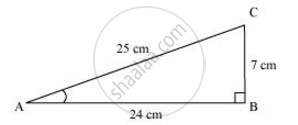Advertisements
Advertisements
Question
In ΔABC right angled at B, AB = 24 cm, BC = 7 m. Determine:
sin C, cos C
Solution
ΔABC is right angled at B
AB = 24cm, BC = 7cm.

Let ‘x’ be the hypotenuse,
By applying Pythagoras
AC2 = AB2 + BC2
x2 = 242 + 72
x2 = 576 + 49
x2 = 625
x = 25
For Sin C, Cos C
sin C = `("AB")/("AC") = 24/25`
cos C = `("BC")/("AC") = 7/25`
APPEARS IN
RELATED QUESTIONS
In ΔPQR, right angled at Q, PR + QR = 25 cm and PQ = 5 cm. Determine the values of sin P, cos P and tan P.
State whether the following are true or false. Justify your answer.
sec A = `12/5` for some value of angle A.
In the following, trigonometric ratios are given. Find the values of the other trigonometric ratios.
`sin A = 2/3`
In the following, trigonometric ratios are given. Find the values of the other trigonometric ratios.
`cos A = 4/5`
If 3 tan θ = 4, find the value of `(4cos theta - sin theta)/(2cos theta + sin theta)`
If sec θ = `13/5, "show that" (2sinθ - 3 cosθ)/(4sinθ - 9cosθ) = 3`.
Evaluate the following
sin 45° sin 30° + cos 45° cos 30°
Evaluate the Following
(cos 0° + sin 45° + sin 30°)(sin 90° − cos 45° + cos 60°)
If sin (A − B) = sin A cos B − cos A sin B and cos (A − B) = cos A cos B + sin A sin B, find the values of sin 15° and cos 15°.
The value of cos 0°. cos 1°. cos 2°. cos 3°… cos 89° cos 90° is ______.
Prove the following:
If tan A = `3/4`, then sinA cosA = `12/25`
Prove that sec θ + tan θ = `cos θ/(1 - sin θ)`.
Proof: L.H.S. = sec θ + tan θ
= `1/square + square/square`
= `square/square` ......`(∵ sec θ = 1/square, tan θ = square/square)`
= `((1 + sin θ) square)/(cos θ square)` ......[Multiplying `square` with the numerator and denominator]
= `(1^2 - square)/(cos θ square)`
= `square/(cos θ square)`
= `cos θ/(1 - sin θ)` = R.H.S.
∴ L.H.S. = R.H.S.
∴ sec θ + tan θ = `cos θ/(1 - sin θ)`
Find the value of sin 0° + cos 0° + tan 0° + sec 0°.
Prove that: cot θ + tan θ = cosec θ·sec θ
Proof: L.H.S. = cot θ + tan θ
= `square/square + square/square` ......`[∵ cot θ = square/square, tan θ = square/square]`
= `(square + square)/(square xx square)` .....`[∵ square + square = 1]`
= `1/(square xx square)`
= `1/square xx 1/square`
= cosec θ·sec θ ......`[∵ "cosec" θ = 1/square, sec θ = 1/square]`
= R.H.S.
∴ L.H.S. = R.H.S.
∴ cot θ + tan θ = cosec·sec θ
If sec θ = `1/2`, what will be the value of cos θ?
If f(x) = `3cos(x + (5π)/6) - 5sinx + 2`, then maximum value of f(x) is ______.
If `θ∈[(5π)/2, 3π]` and 2cosθ + sinθ = 1, then the value of 7cosθ + 6sinθ is ______.
Evaluate 2 sec2 θ + 3 cosec2 θ – 2 sin θ cos θ if θ = 45°.
(3 sin2 30° – 4 cos2 60°) is equal to ______.
